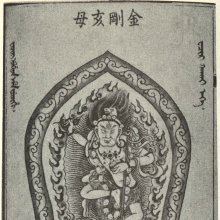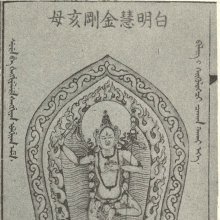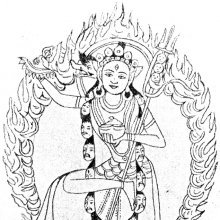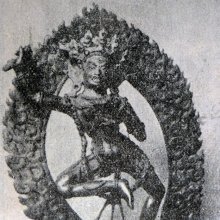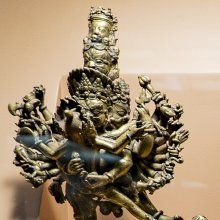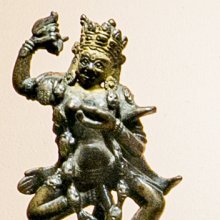Vajravarahi, Vajravārāhī: 9 definitions
Introduction:
Vajravarahi means something in Buddhism, Pali, Hinduism, Sanskrit. If you want to know the exact meaning, history, etymology or English translation of this term then check out the descriptions on this page. Add your comment or reference to a book if you want to contribute to this summary article.
Images (photo gallery)
(+11 more images available)
In Buddhism
Tibetan Buddhism (Vajrayana or tantric Buddhism)
Source: Google Books: VajrayoginiVajravārāhī (वज्रवाराही) is deep red in color, a reflex of her red seed-syllable vaṃ. The Vajravārāhī-sādhana describes her as “saffron-colored” (kāśmīra-varṇa), but elsewhere she is compared to vermilion powder (sindūra)., or to startlingly red flowers such as the China rose (javākusuma), and the pomegranate flwoer (dāḍima). Her radiance is likened to the fire that blazes at the end of the aeon.
The Vajravārāhī-sādhana describes Vajravārāhī as having one head, just as she had as consort to Cakrasaṃvara—that is, without her eponymous charatacteristic, the hog’s head (varāha), which appears in her other main manifestation. Her face is fanged and has three eyes; these are a standard feature of tantric iconograph drawn from the iconography of Śiva. In her two arms she holds her particular attributes, a vajra and a skull bowl filled with blood; these are held in her right and left hands respectively (as seen from the point of view of the meditator/deity herself).
Other tantric ornaments adorn Vajravārāhī’s body. She wears a garland of heads, fifty in number corresponding to the fifty vowels and consonants, and said in the Vajravārāhī-sādhana to be bloody, that is, freshly severed and dripping. Vajravārāhī is also beautified by a set of five tantric ornaments, all made of human bone, and known collectively as the five mudrās, or signs—indicating here the signs of kāpālika observance.
Source: archive.org: The Indian Buddhist Iconography1) Vajravārāhī (वज्रवाराही) is the name of female deity represented as the Prajñā (counterpart) of various male deities, according to the 5th-century Sādhanamālā (a collection of sādhana texts that contain detailed instructions for rituals).—Vajravārāhī is mentioned as the Prajñā or Śakti of: (four-armed) Hevajra, (two-armed) Sambara, (twelve-armed) Sambara, (six-armed) Saptākṣara.
2) Vajravārāhī (वज्रवाराही) refers to one of the emanations of Vairocana, as mentioned in the 5th-century Sādhanamālā (a collection of sādhana texts that contain detailed instructions for rituals).—Her Colour is red; her Appearance is nude; her Āsana is the pratyālīḍha; her Symbols are the vajratarjanī and kapāla; she has two arms.
The name Vajravārāhī or ‘adamantine sow’ is given to her for the simple reason that she has an excrescence near her right ear which resembles the face of a sow. The union of Vajravārāhī with Heruka is the cult of the celebrated Cakrasaṃvara Tantra. One of the Sādhanas gives her the epithet of “Śrī Herukadevasyāgramahiṣī” or “the first queen of the god Śrī-Heruka”. She is also called a Ḍākinī and in the Buddhist Tantra this signifies any Śakti with whom the Yuganaddha (yab-yum) worship may be performed.
The Dhyāna (meditation instructions) of Aśokakāntā described in the Sādhanamālā as follows:—
“The worshipper should think himself as goddess Vajravārāhī whose colour is red like the pomegranate flower and is two-armed. She exhibits in her right hand the vajra along with the raised index finger,and shows in the left the kapāla and the khaṭvāṅga. She is one-faced and three-eyed, has dishevelled hair, is marked with the six auspicious symbols and is nude. She is the essence of the five kinds of knowledge, and is the embodiment of the Sahaja pleasure. She stands in the pratyālīḍha attitude, tramples upon the gods Bhairava and Kālarātri, wears a garland of heads still wet with blood which she drinks”
[The Sādhana further adds that the four petals of the lotus on which she stands are occupied by the four goddesses Ḍākinī, Lāmā, Khaṇḍarohā and Rūpiṇī in the four cardinal directions beginning from the right. The four companions are of blue, green, red and white colour respectively, and they are all one-faced and four-armed. They all carry the khaṭvaṅga, the kapāla in the left hands and the ḍamaru and the kartri in the two right hands.]
2) Vajravārāhī (वज्रवाराही) refers to one of the six Goddesses standing on the six spokes of the wheel of the sun, according to the Saptākṣara-sādhana.—Accordingly, [...] on each of the six spokes of the wheel of the sun on which the god stands there are six deities, namely, (commencing from the right) Herukī, Vajravārāhī, Ghoracaṇḍī, Vajrabhāskarī, Vajraraudrī and Vajraḍākinī. They have respectively blue, yellow, red, green, smoky and white colour. All of them have dishevelled hair, fierce appearance, three eyes and the quarters as garments. They carry the resounding ḍamaru and the ghaṇṭā in the first pair of hands, and the human skin in the other pair. They [viz., Vajravārāhī] stand on the orb of the sun placed on a corpse. Their head-dresses are decorated with rows of skulls, and they stand in the ālīḍha attitude
Source: academia.edu: The Structure and Meanings of the Heruka MaṇḍalaVajravārāhī (वज्रवाराही) is the consort of Heruka: the main deitiy of the Herukamaṇḍala described in the 10th century Ḍākārṇava chapter 15. Heruka is positioned in the Lotus (padma) at the center; She has one face (with three eyes on it) and two arms; She holds an adamantine knife (vajrakarttṛ) with the right hand and a skull bowl with the left hand; She is red in color; She hugs Heruka with her legs.
Source: OSU Press: Cakrasamvara SamadhiVajravārāhī (वज्रवाराही) is the name of a deity, according to the Saṃvaramaṇḍala of Abhayākaragupta’s Niṣpannayogāvalī, p. 45 and n. 145; (Cf. Cakrasaṃvaratantra, Gray, David B., 2007).—Vajravārāhī appears both with Cakrasaṃvara, and on her own, both as Vajravārāhī and Vajrayoginī. On her own as Vajravārāhī she appears dancing in half paryaṅka, (ardhaparyaṅka-nṛtyā) the most common posture for Ḍākinīs. Paryaṅka is a common sitting posture for meditation, where the bent knees point forward, feet point back, with hamstrings resting on the calves. Dancing in half paryaṅka, is a standing posture, where one leg is lifted in ardhaparyaṅka, and the other is on the ground, indicating a joyous and passionate Buddha nature. [...] Vajravārāhī and Vajrayoginī are both red, nagnā, "naked", have muktakeśā, "loosened hair", one face and two arms, three eyes, holding a kartika in the right hand, and kapāla in the left, a garland of fifty dried human skulls, five bone ornaments, a crown of five skulls, and hold a khaṭvāṅga. With Cakrasaṃvara, Vajravārāhī has either one or both legs wrapped around her hero, copulating while menstruating. Both Vajravārāhī and Vajrayoginī have their own iconographic meanings with and without Cakrasaṃvara.

Tibetan Buddhism includes schools such as Nyingma, Kadampa, Kagyu and Gelug. Their primary canon of literature is divided in two broad categories: The Kangyur, which consists of Buddha’s words, and the Tengyur, which includes commentaries from various sources. Esotericism and tantra techniques (vajrayāna) are collected indepently.
Languages of India and abroad
Sanskrit dictionary
Source: Cologne Digital Sanskrit Dictionaries: Edgerton Buddhist Hybrid Sanskrit DictionaryVajravārāhī (वज्रवाराही).—name of a yoginī: Dharmasaṃgraha 13; Sādhanamālā 424.1; 427.1, etc.
Source: Cologne Digital Sanskrit Dictionaries: Shabda-Sagara Sanskrit-English DictionaryVajravarāhī (वज्रवराही).—f. (-hī) A female personification of Maya or unreality, amongst the Baud'dhas.
Source: Cologne Digital Sanskrit Dictionaries: Monier-Williams Sanskrit-English DictionaryVajravārāhī (वज्रवाराही):—[=vajra-vārāhī] [from vajra > vaj] f. Name of a Tantra goddess, [Monier-Williams’ Buddhism 491; 526] (cf. -kālikā).
Source: Cologne Digital Sanskrit Dictionaries: Yates Sanskrit-English DictionaryVajravārāhī (वज्रवाराही):—[vajra-vārāhī] (hī) 3. f. A female personification of Maya or unreality.
[Sanskrit to German]
Sanskrit, also spelled संस्कृतम् (saṃskṛtam), is an ancient language of India commonly seen as the grandmother of the Indo-European language family (even English!). Closely allied with Prakrit and Pali, Sanskrit is more exhaustive in both grammar and terms and has the most extensive collection of literature in the world, greatly surpassing its sister-languages Greek and Latin.
See also (Relevant definitions)
Partial matches: Vajra, Varahi.
Starts with: Vajravarahika, Vajravarahitantra.
Ends with: Aryavajravarahi, Shrivajravarahi, Vasyavajravarahi.
Full-text (+309): Vajrayogini, Vanaratna, Nagna, Muktakesha, Khaganana, Anjana, Ardhaparyanka, Paryanka, Pratyalidhasana, Shrivajravarahi, Atyantavarada, Jineshvari, Aryavajravarahi, Raktabindunivasini, Mantramurti, Cakrasamvarasamadhi, Vyaghracarman, Vak Hevajra, Rucaka, Kanthi.
Relevant text
Search found 7 books and stories containing Vajravarahi, Vajravārāhī, Vajravarāhī, Vajra-varahi, Vajra-vārāhī, Vajravaarahi; (plurals include: Vajravarahis, Vajravārāhīs, Vajravarāhīs, varahis, vārāhīs, Vajravaarahis). You can also click to the full overview containing English textual excerpts. Below are direct links for the most relevant articles:
Shakti and Shakta (by John Woodroffe)
Chapter XXVIII - Matam Rutra (the Right and Wrong Interpretation) < [Section 3 - Ritual]
The Indian Buddhist Iconography (by Benoytosh Bhattachacharyya)
Figure 159-160 - Emanations of Vairocana: Vajravārāhī
Figure 152-155 - Emanations of Vairocana: Aṣṭabhuja and Daśabhujasita Mārīcī
Stupas in Orissa (Study) (by Meenakshi Chauley)
Buddhist Icons as depicted on the Stupas (Introduction) < [Chapter 5]
Uddiyana Pitha (in Tantric Buddhism) < [Chapter 2]
The gods of northern Buddhism (by Alice Getty)
Varahi Tantra (English Study) (by Roberta Pamio)
Guhyagarbha Tantra (with Commentary) (by Gyurme Dorje)
Commentary 1-2: Teachings on the Wrathful Deities < [Chapter 15 (Text and Commentary)]
Related products
